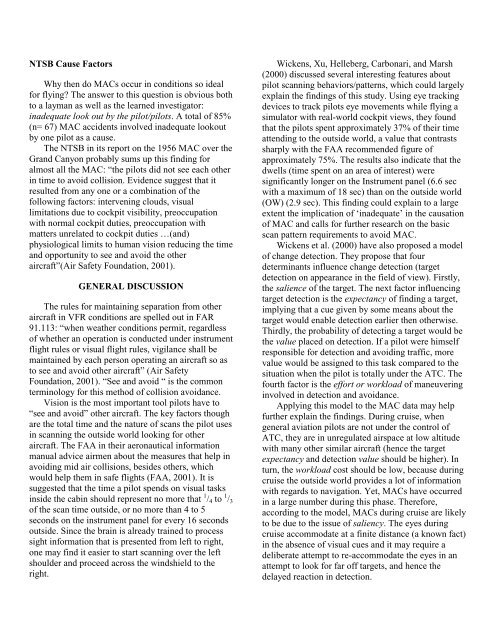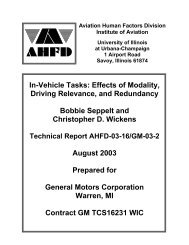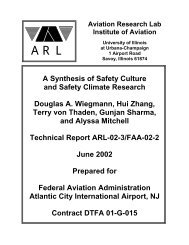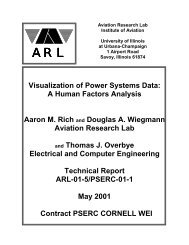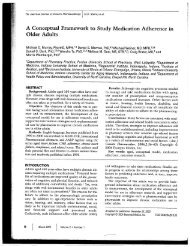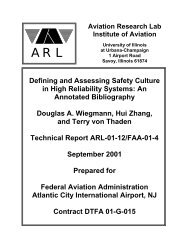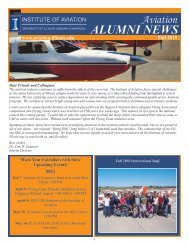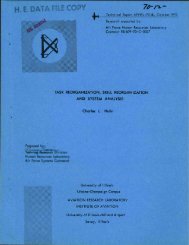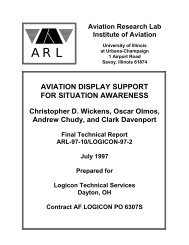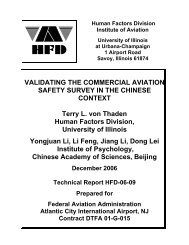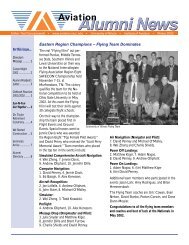ANALYSIS OF MID-AIR COLLISIONS IN CIVIL AVIATION Narinder ...
ANALYSIS OF MID-AIR COLLISIONS IN CIVIL AVIATION Narinder ...
ANALYSIS OF MID-AIR COLLISIONS IN CIVIL AVIATION Narinder ...
Create successful ePaper yourself
Turn your PDF publications into a flip-book with our unique Google optimized e-Paper software.
NTSB Cause FactorsWhy then do MACs occur in conditions so idealfor flying? The answer to this question is obvious bothto a layman as well as the learned investigator:inadequate look out by the pilot/pilots. A total of 85%(n= 67) MAC accidents involved inadequate lookoutby one pilot as a cause.The NTSB in its report on the 1956 MAC over theGrand Canyon probably sums up this finding foralmost all the MAC: “the pilots did not see each otherin time to avoid collision. Evidence suggest that itresulted from any one or a combination of thefollowing factors: intervening clouds, visuallimitations due to cockpit visibility, preoccupationwith normal cockpit duties, preoccupation withmatters unrelated to cockpit duties …(and)physiological limits to human vision reducing the timeand opportunity to see and avoid the otheraircraft”(Air Safety Foundation, 2001).GENERAL DISCUSSIONThe rules for maintaining separation from otheraircraft in VFR conditions are spelled out in FAR91.113: “when weather conditions permit, regardlessof whether an operation is conducted under instrumentflight rules or visual flight rules, vigilance shall bemaintained by each person operating an aircraft so asto see and avoid other aircraft” (Air SafetyFoundation, 2001). “See and avoid “ is the commonterminology for this method of collision avoidance.Vision is the most important tool pilots have to“see and avoid” other aircraft. The key factors thoughare the total time and the nature of scans the pilot usesin scanning the outside world looking for otheraircraft. The FAA in their aeronautical informationmanual advice airmen about the measures that help inavoiding mid air collisions, besides others, whichwould help them in safe flights (FAA, 2001). It issuggested that the time a pilot spends on visual tasksinside the cabin should represent no more that 1 / 4 to 1 / 3of the scan time outside, or no more than 4 to 5seconds on the instrument panel for every 16 secondsoutside. Since the brain is already trained to processsight information that is presented from left to right,one may find it easier to start scanning over the leftshoulder and proceed across the windshield to theright.Wickens, Xu, Helleberg, Carbonari, and Marsh(2000) discussed several interesting features aboutpilot scanning behaviors/patterns, which could largelyexplain the findings of this study. Using eye trackingdevices to track pilots eye movements while flying asimulator with real-world cockpit views, they foundthat the pilots spent approximately 37% of their timeattending to the outside world, a value that contrastssharply with the FAA recommended figure ofapproximately 75%. The results also indicate that thedwells (time spent on an area of interest) weresignificantly longer on the Instrument panel (6.6 secwith a maximum of 18 sec) than on the outside world(OW) (2.9 sec). This finding could explain to a largeextent the implication of ‘inadequate’ in the causationof MAC and calls for further research on the basicscan pattern requirements to avoid MAC.Wickens et al. (2000) have also proposed a modelof change detection. They propose that fourdeterminants influence change detection (targetdetection on appearance in the field of view). Firstly,the salience of the target. The next factor influencingtarget detection is the expectancy of finding a target,implying that a cue given by some means about thetarget would enable detection earlier then otherwise.Thirdly, the probability of detecting a target would bethe value placed on detection. If a pilot were himselfresponsible for detection and avoiding traffic, morevalue would be assigned to this task compared to thesituation when the pilot is totally under the ATC. Thefourth factor is the effort or workload of maneuveringinvolved in detection and avoidance.Applying this model to the MAC data may helpfurther explain the findings. During cruise, whengeneral aviation pilots are not under the control ofATC, they are in unregulated airspace at low altitudewith many other similar aircraft (hence the targetexpectancy and detection value should be higher). Inturn, the workload cost should be low, because duringcruise the outside world provides a lot of informationwith regards to navigation. Yet, MACs have occurredin a large number during this phase. Therefore,according to the model, MACs during cruise are likelyto be due to the issue of saliency. The eyes duringcruise accommodate at a finite distance (a known fact)in the absence of visual cues and it may require adeliberate attempt to re-accommodate the eyes in anattempt to look for far off targets, and hence thedelayed reaction in detection.


